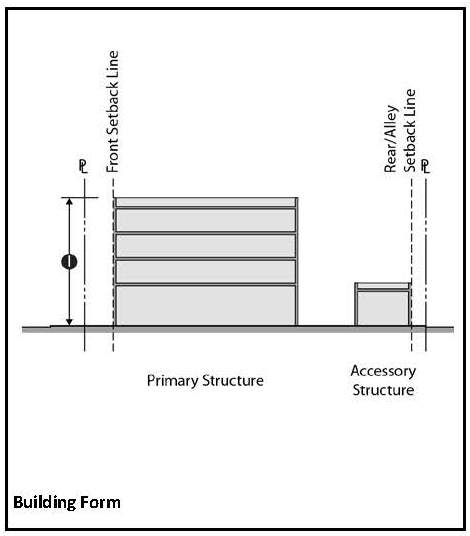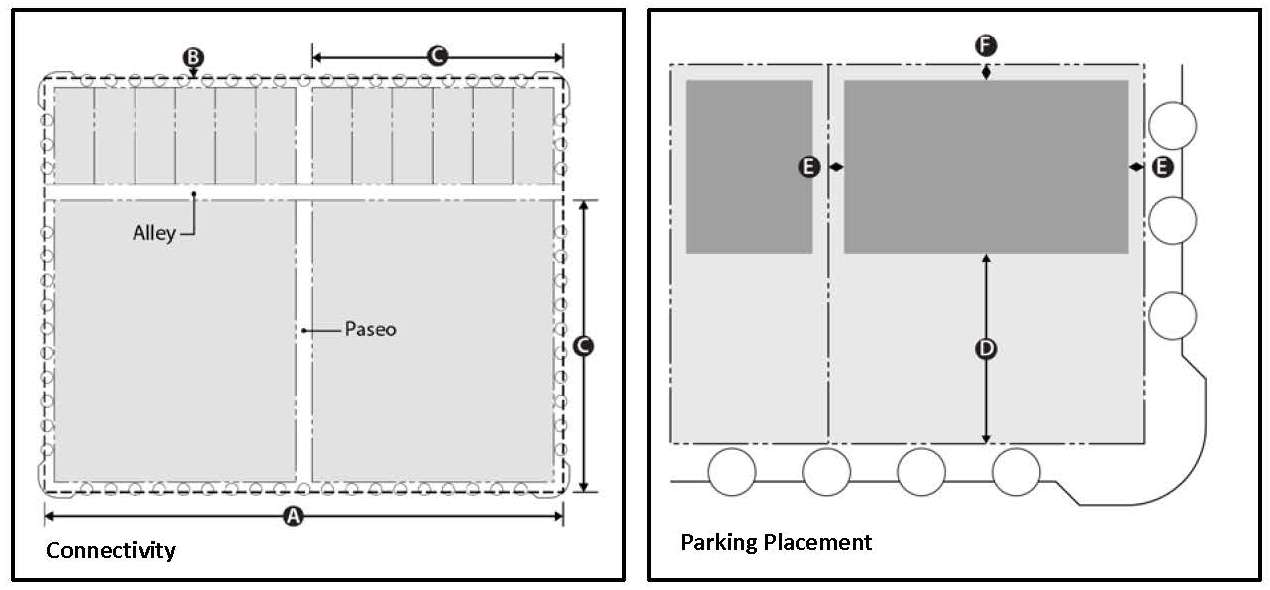Chapter 23.504
VILLAGE CENTER ZONE STANDARDS
Sections:
23.504.020 Building placement.
23.504.050 Allowed frontage types.
23.504.060 Allowed streetscape types.
23.504.080 Connectivity and parking.
Prior legislation: Ord. 27-2008.
23.504.010 Purpose.
The purpose of the village center zone is to provide centers of activity that are within an easy walking distance from neighborhood homes and to provide local-serving commercial opportunities. A network of sidewalks, bicycle trails, and transit routes provides easy nonvehicular access to these centers. Buildings in this zone are appropriately scaled to fit in the neighborhood context. Buildings are placed close to the public sidewalk, and plazas and other public spaces encourage the active use of public spaces and pedestrian activity. Parking is provided on-street, in small lots, and/or located behind or to the side of buildings. Transit-supportive development is encouraged when located in proximity to a transit station. Vertical and/or horizontal mixed-use projects are encouraged in this zone. [Ord. 4-2017 § 3 (Exh. B)].
23.504.020 Building placement.
|
Setback |
|
|
Primary Building Setback (build-to line) |
|
|
Front setback (A) |
10 feet min. 20 feet max. |
|
Side yard (B) |
5 feet min. |
|
Side street or internal circulation street (C) |
0 feet min. 10 feet max. |
|
Rear yard and alley (D) |
5 feet min. |
|
Accessory Building Placement |
|
|
Front yard (E) |
30 feet min. |
|
Side yard (F) |
10 feet min. |
|
Side street (G) |
5 feet min. |
|
Rear yard and alley (H) |
5 feet min. |
[Ord. 4-2017 § 3 (Exh. B)].
23.504.030 Building form.
|
Building Frontage |
|
|
Primary street |
50% |
|
Side street1 |
40% |
|
Floor Area Ratio (FAR) |
|
|
Minimum FAR |
0.25 |
|
Maximum FAR |
1.0 |
|
Building Height |
|
|
Minimum height |
n/a |
|
Maximum height (I) |
45 feet |
1. Building is located within required side yard or side street or circulation street area.
[Ord. 4-2017 § 3 (Exh. B)].
23.504.040 Allowed use types.
|
Neighborhood-serving commercial (generally smaller grocery stores, drug stores, dry cleaners, coffee shops, etc.). |
|
Community centers |
|
Public/quasi-public uses that incorporate community gathering places |
|
Public/quasi-public uses without gathering places (as secondary uses) |
|
Office uses (as secondary uses) |
|
Medium density residential (as secondary uses, 6.1 to 18.0 units per acre) |
[Ord. 4-2017 § 3 (Exh. B)].
23.504.050 Allowed frontage types.
Allowed frontage types are associated with each streetscape type. See allowed streetscape types below and Chapter 23.513 RCMC, Streetscape Type and Frontage Type Standards. [Ord. 4-2017 § 3 (Exh. B)].
23.504.060 Allowed streetscape types.
|
Minor Arterial |
|
Nonresidential Collector Street |
|
Residential Collector Street |
|
Main Street |
|
Nonresidential Local Street |
|
Standard Residential Street |
|
Minor Residential Street |
|
Alley |
|
Paseo |
|
Multi-Use Path |
[Ord. 4-2017 § 3 (Exh. B)].
23.504.070 Density.
|
Minimum density |
6.1 du/acre |
|
Maximum density |
18 du/acre |
[Ord. 4-2017 § 3 (Exh. B)].
23.504.080 Connectivity and parking.
|
Connectivity3 |
|
|
Maximum block length (A) |
600 feet |
|
Maximum block perimeter (B) |
2,000 feet |
|
Maximum pedestrian block length (C) |
350 feet |
|
Parking Placement |
|
|
Setbacks from public or private streets (D) |
Rear 50% of lot |
|
Side yard setback (E) |
5 feet min. (except for shared parking) |
|
Rear yard and alley setback (F) |
5 feet min. |
|
Required Spaces |
|
|
Parking ratios must meet city standards as identified in Municipal Code Title 23 Chapter 23.719. |
|
3. Pedestrian connections must comply with the specifications for paseos or multi-use paths outlined in Chapter 23.513 RCMC (Streetscape Type and Frontage Type Standards).
Internal circulation streets are private or public streets on commercial or residential lots which access either buildings or parking areas. Internal circulation streets must be provided every 350 feet along any one block face (minimum) and must comply with the specifications for main street, nonresidential collector street (commercial), standard residential street, or minor residential street outlined in Chapter 23.513 RCMC (Streetscape Type and Frontage Type Standards).
Pedestrian connections and internal circulation streets must connect on at least two ends to public or private pedestrian or vehicular routes.
[Ord. 4-2017 § 3 (Exh. B)].


